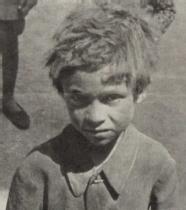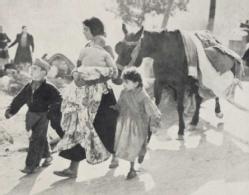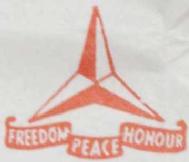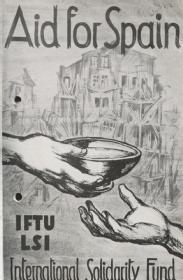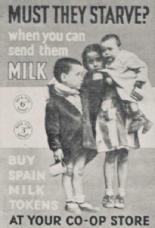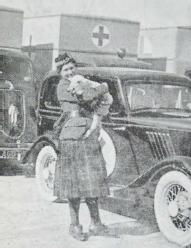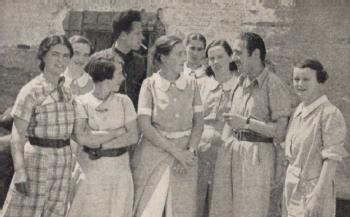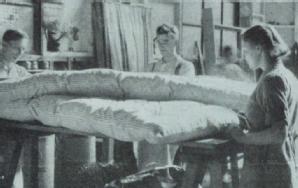Aid to Spain
This is an overview of the main 'single issue' aid organisations operating in Britain during and immediately after the Spanish Civil War. Documents relating to all of the organisations listed below are included in the archives of the Trades Union Congress.
Information about the role of the Red Cross during the conflict is included in the website of International Committee of the Red CrossLink opens in a new window.
Basque Children's Committee (BCC)
Chairman: The Duchess of Atholl.
Vice-Chairmen: Eleanor Rathbone M.P., Vincent Tewson.
Honorary Secretaries: Wilfrid Roberts M.P., J.R.J. Macnamara M.P., D.R. Grenfell M.P.
Honorary Treasurer: Viscount Cecil of Chelwood.
Organising Secretary: Dr Betty Morgan.
Background: The Basque Children's CommitteeLink opens in a new window was an offshoot of the National Joint Committee for Spanish Relief, and was set up to manage the maintenance of nearly 4,000 Basque children evacuated to the UK on the ship "HabanaLink opens in a new window" in May 1937. It was responsible for the management of approximately 40 homes in England, Scotland and Wales.
Attitude of the Trades Union Congress General Council: The TUC played a key role in the establishment, administration and funding of the Basque Children's Committee. At the beginning of May 1937, Sir Walter Citrine (TUC General Secretary) discussed arrangementsLink opens in a new window for the planned evacuation of Basque children with the Basque government representative in Britain, José I. Lizaso, Labour Party politicians, and members of the National Joint Committee for Spanish Relief. This resulted in the formation of the Basque Children's Committee.
British Committee for Refugees from Spain
Chairman: Eleanor Rathbone, M.P.
Hon. Secretary: Wilfrid Roberts, M.P.
Organising Secretary: Elizabeth Montagu-Pollock.
Hospitality Secretary: Joan Priestley.
Aid included: Providing material aid and advice to individuals in Britain and France; contributing to the establishment of a central organisation in Perpignan for the issuing of food and clothes to refugees in transit; establishing a home for 100 refugees in Narbonne; helping refugees to emigrate to South America (including co-chartering the S.S. SinaiaLink opens in a new window to transport 1,800 refugees from France to Mexico); publicising living conditions in the French refugee camps.
Background: The British Committee for Refugees from SpainLink opens in a new window was formed in 1939, shortly before the end of the Spanish Civil War. It was affiliated to the National Joint Committee for Spanish Relief.
Foster Parents' Scheme for Spanish Children
British Headquarters, London: John Langdon-Davies, Chairman.
American Headquarters, New York: Eric Muggeridge, Secretary; David J. Algase, Treasurer.
Aid included: Support for Spanish children in Spain, France and Britain.
Background: The Foster-Parents Scheme for Spanish Children was created in Britain by John Langdon-Davies in January 1937, and was extended to the USA later in that year. 'Foster parents'Link opens in a new window paid a regular sum to sponsor an individual child, who would be cared for in 'colonies' funded by the scheme. In return the sponsors would receive photographs, drawings, letters or other personal tokens from the children that they were supporting. The Foster-Parents Scheme for Spanish Children was affiliated to the National Joint Committee for Spanish Relief.
Also known as: the Foster Parents' Plan for Children in Spain and the Foster Parents' Plan for War Children. It later became the international children's charity PlanLink opens in a new window.
International Brigade Dependants' and Wounded Aid Committee
(Later known as the International Brigade AssociationLink opens in a new window)
Officers included (at various dates): President: Sam Wild; Vice-Presidents: Malcolm Dunbar, Alan Gilchrist; Hon. Secretaries / Secretaries: Charlotte Haldane, Jack Brent, Nan Green, Alec Digges.
Aid included: Payment of grants, allowances and medical expenses of former members of the International Brigade and their dependants.
Background: The Committee was formed in 1937.
Attitude of the Trades Union Congress General Council: The TUC refused to support the International Brigade Dependants' and Wounded Aid CommitteeLink opens in a new window due to its links with the Communist Party. The committee did however receive money and support from individual trade unions at both national and branch level (including from the sections of the Amalgamated Engineering Union, the Miners' Federation of Great Britain, and the Amalgamated Society of Woodworkers).
Archives elsewhere: The main British archives of the International Brigade are held at the Marx Memorial LibraryLink opens in a new window.
International Red Aid
Aid included: food, medical supplies, building work, education.
Background: Influenced by the Communist Party of Poland's creation of a fund to aid political prisoners in August 1922, the Communist InternationalLink opens in a new window (also known as the Third International or the CominternLink opens in a new window) passed a resolution on 30 November 1922, calling on all Communist Parties to form organisations in support of an 'International Association for the Support of the Champions of Revolution'. The Central Committee of the renamed 'International Red AidLink opens in a new window' was formed on 2 March 1923, and the Communist International counted its official first day of action as being 18 March 1923 (the anniversary of the Paris Commune). International Red Aid had also provided aid to Spain in 1934, after the suppressed uprising in Asturias. [Information on the formation of the IRA taken from International Press Correspondence, vol.8, no.13, 7 March 1928]
The independent communist party Partido Obrero de Unificación MarxistaLink opens in a new window (POUMLink opens in a new window) set up a rival 'Red Aid' organisation during the Spanish Civil War.
Attitude of the Trades Union Congress General Council: The International Federation of Trade Unions and its British affiliate, the TUC, objected to the International Red Aid as it was a Communist organisation funded by the Soviet Union. As well as their ideological objections to Communism, they also argued that the International Red Aid was used as primarily a propaganda tool, rather than a humanitarian organisation, and suggested that the aid was partisan - going to Communist supporters and not necessarily those (on the Republican side) who were most in need.
International Solidarity Fund (ISF)
Committee in UK included: General Council of the Trades Union Congress, Executive Committee of the Labour Party.
Co-ordinator of aid in Spain: Enrique Santiago.
Aid to Spain included: OntenienteLink opens in a new window base hospital on the Madrid Front (opened in Spring 1937); medical supplies and personnel; transport for supplies, refugees and the wounded; food, clothing and cigarettes; maintenance of children's colonies in Spain; maintenance of refugee children in Britain, France, Switzerland and Belgium; maintenance of Spanish and Basque sailors in Britain.
Background: The Matteotti Fund was established in April 1926 by the Labour and Socialist InternationalLink opens in a new window (LSI), in memory of Giacomo Matteotti, an Italian socialist politician who was murdered by fascists in 1924. It was intended as an "international fund to help the labour movement in countries without democracy", and was used to provide aid to help victims of fascist persecution (particularly in Germany, Austria and Italy). The International Federation of Trade UnionsLink opens in a new window (IFTU) agreed to co-administer the fund in 1930, and it was later renamed the International Solidarity FundLink opens in a new window (ISF). In July 1936 the LSI and IFTU agreed that the International Solidarity Fund would provide aid for the Spanish Republic. The ISF received donations primarily from the national trade union and democratic socialist organisations affiliated to the LSI and IFTU, and co-ordinated the distribution of aid in Spain through its two Spanish affiliates (the Spanish Socialist Party and the Unión General de Trabajadores (UGT)). Fundraising for the ISF in Britain was co-ordinated by the National Council of LabourLink opens in a new window (a joint committee of the Trades Union Congress and the Labour Party). As well as providing aid directly, the ISF also gave out grants to other organisations which it considered to be politically suitable (i.e. not in any way associated with the Communist Party).
Attitude of the Trades Union Congress General Council: The TUC wanted all donations from the labour movement to be co-ordinated by the International Solidarity Fund, allowing centralised control of the funds without any 'united front' style co-operation with the Communist Party.
Labour Party Spain Campaign Committee
Chairman: George Dallas.
Secretaries: William Gillies, Ellen Wilkinson M.P.
Aid included: "Milk for SpainLink opens in a new window" fund; Christmas food parcelsLink opens in a new window (1938).
Background: Formed in 1937 after the Labour Party annual conference "instructed the National Executive to undertake a nation-wide campaign forthwith to compel the Government to abandon the Non-Intervention Agreement and to restore to the elected and constitutional Government of Spain its freedom to purchase armsLink opens in a new window", the Spain Campaign CommitteeLink opens in a new window was intended to co-ordinate Labour Party propaganda work (including the organisation of a big demonstration at the Albert Hall), as well as fundraising for Republican Spain. The "Milk for Spain" fund raised money through the sale of tokens at branches of the Co-operative Society.
Attitude of the Trades Union Congress General Council: Whilst the TUC saw "special circumstances" with the "Milk for Spain" fund which justified the setting up of a new fund separate from the International Solidarity Fund, it strongly objectedLink opens in a new window to the Labour Party's scheme for Christmas food parcels. This was due, in part, to the involvement of the National Committee for Aid to Spain, a organisation with Communist links.
Archives elsewhere: Records of the Labour Spain CommitteeLink opens in a new window are held by Churchill Archives Centre, Cambridge.
National Joint Committee for Spanish Relief
(Often abbreviated to the National Joint CommitteeLink opens in a new window or NJC)
Chairman: The Duchess of Atholl.
Vice-Chairmen: The Earl of Listowel, Eleanor Rathbone M.P.
Treasurers: Wilfrid Roberts M.P., Viscount Cecil of Chelwood.
Honorary Secretaries: D.R. Grenfell M.P., Captain J.R.J. Macnamara M.P., Wilfrid Roberts M.P.
Organising Secretaries: Elizabeth Macadam, Mary M. Miller, Betty Arne, Dr Betty Morgan.
Assistant Secretary: Felice Clark.
Aid to Spain included: Transport, including buses to be used to evacuate civilians from warzones; medical supplies, including ambulances, hospital equipment and medicine; food, clothing, petrol; assistance for refugees from Franco's Spain to emigrate, including the co-chartering of the S.S. SinaiaLink opens in a new window to transport 1,800 refugees from France to Mexico.
Background: An all-party group of six British Members of ParliamentLink opens in a new window visited Madrid, Valencia and Barcelona in November 1936. On their return they called a meeting of representatives of organisations involved in humanitarian work in Spain, with the intention of forming a national joint committeeLink opens in a new window to co-ordinate appeals for aid, allocate funds raised and reduce the costs of transporting goods to Spain. It was intended that the work of the NJC "should be purely humanitarian and non-sectarian in character"Link opens in a new window. Local branches operated with a degree of autonomy, and raised funds through a wide variety of means, including concerts, lectures, exhibitions (including an exhibition of Picasso's 'Guernica' at the New Burlington Galleries, London, in October 1938), cinema screenings, house to house collections, and appeals to newspapers (local and national).
Co-operating societies included: British Committee for Refugees from Spain, Christian Foodship Committee, Save the Children Fund, Scottish Ambulance Unit, Service Council of the Society of Friends, Southern Spanish Relief Committee, Spanish Medical Aid Committee, Spanish Women's Committee for Help to Spain, Spanish Youth Foodship Committee, Women's Committee Against War and Fascism.
Attitude of the Trades Union Congress General Council: The TUC did not support the National Joint Committee for Spanish Relief, as it operated as a 'united front' style organisation, including members of the Communist Party. The idea of having largely autonomous local committees also went against the TUC's preference for centralised control over organisation and funds.
Relief Committee for Victims of Fascism
(later incorporated into the Anti-Fascist Relief CommitteeLink opens in a new window)
Chairman: Dr J. Kershaw.
Treasurers: Dr H.C. Boyde, Professor J.B.S. Haldane.
Secretary: Isabel Brown.
International Presidents: Lord Marley, Paul Langevin.
Vice Presidents: Professor Julian Huxley, Professor W.B. Brierley, Professor Blackett, Maurice Dobb, Professor Lascelles Abercrombie, F.L. Lucas, Hilda Browning, Aldous Huxley, Miles Malleson, Louis Golding, Etienne Watts, P.C. Gordon Walker, Laurence Housman, P.M. Oliver, Leah Manning, J.L. Gunn, Augustus John, C.K. Cullen.
Aid to Spain included: Provision of food, clothing, medical supplies and transport. After the end of the war, provided aid to refugees in France.
Attitude of the Trades Union Congress General Council: The Relief Committee for Victims of FascismLink opens in a new window was a proscribed organisation (i.e. affiliates of the TUC were not allowed to support it), due to its Communist connections.
Scottish Ambulance Unit in Spain
Committee included: Sir Daniel Macaulay Stevenson (Chairman); Ishbel, Marchioness of Aberdeen and Temair; The Countess of Oxford and Asquith; Sir Henry Ballantyne; William Black; P.J. Dollan, William Elger; A. Forrester-Paton; Hon. Mrs Forrester-Paton; Professor and Mrs Glaister; Sir Thomas and Lady Glen-Coats; Mrs John M. Hogg; Fernanda Jacobsen; Sir John Mann; Sir David Mason; David Perry; Sir Andrew H. Pettigrew; Ralph Risk; Mrs Raynes; Sir Archibald Sinclair; Lady Swan; Professor Walton; Lady Wilson of Uddingston.
Personnel in Spain included: Fernanda Jacobsen (Commandant), Mr Boyd, Elsie Brook, - Burleigh, Joseph Carlin, Dr Leonard Crome, - Gallie, - Girvan, John Learmont, Morris Linden, John McDonald, Roderick MacFarquhar, Mr MacMahon, Dr Newbiggin, Donald Perfect, Dr Juan Planelles Ripoll, Joaquin Usallan Morales, Thomas Watters.
Aid to Spain included: Ambulances and personnel; lorries for evacuating civilians and transporting supplies; food.
Background: The Scottish Ambulance UnitLink opens in a new window was formed by the wealthy Glasgow-based businessman Sir Daniel StevensonLink opens in a new window (a supporter of the Liberal Party) and by the end of the war had sent £21,436Link opens in a new window worth of equipment, food and medical supplies to Spain. The first convoy of six ambulances and a lorry left Scotland for Madrid in September 1936, and served during the siege of the Spanish capital. During the first few months in Spain, the unit suffered from a series of problems with its personnel: five members of unit were sent home for "disciplinary reasons"Link opens in a new window immediately after their arrival at the front; two members were captured by Nationalist forces (Boyd and MacMahon); and three members of the unit (Crome, McFarquhar and Linden) resigned in March 1937 over political differencesLink opens in a new window. The Scottish Ambulance Unit initially operated separately from the Spanish Medical Aid CommitteeLink opens in a new window, with which it had an uneasy relationship.
Attitude of the Trades Union Congress General Council: The TUC gave £3,000Link opens in a new window from the International Solidarity Fund to the Scottish Ambulance Unit.
Archives elsewhere: A small amount of material is held by the University of GlasgowLink opens in a new window.
Spanish Medical Aid Committee (SMAC)
President: Lord Christopher Addison.
Chairman: Dr H.B. Morgan.
Vice Chairman: Dr Somerville Hastings.
Treasurers: Viscountess Hastings, Professor J.R. Marrack, Viscount Churchill (stopped being actively involved with SMAC in c.1937).
Honorary Secretaries: Dr Charles Brook (Aug-Dec 1936, subsequently Honorary Medical Secretary), Leah Manning (Dec 1936-1939).
Organising Secretary: George Jeger.
Vice Presidents: Dr Charles Brook, Dr David Forsyth, Victor Gollancz, Professor Julian Huxley, Sir William Jowitt, Sir Walter T. Layton, the Earl of Listowel, Megan Lloyd George M.P., Tom Mann, D.N. Pritt M.P., Eleanor Rathbone M.P., Esther Rickards, Jos. Robinson, Dr Maude Royden, Sir Archibald Sinclair M.P., Ben Tillett, Dr Janet Vaughan, Alfred M. Wall, Rebecca West.
Personnel in Spain included: Kenneth Sinclair-Loutit (administrator of the first medical unit in Spain), Viscount Churchill (also known as Peter Spencer; administrator in Spain, c.1937), Rosita Davson (administrator in Spain from 1937-39); Madge Addy, Dr Gonzalo Aquilo, Keith Andrews, Frank Ayres, Winifred Bates, William Belcher, Julian Bell, Charles Bing, Nurse Bowden, Nurse Briscoe, Dr Bury, Marion Campbell, Sybil Clarke, Archie L. Cochrane (deputy administrator of the first unit), Max Cohen, Percy Cohen, Larry Collier, Mr Coomes, Kathleen Cresswell, Margaret de Culpeper, Dr D'Harcourt, Patience Darton, Nurse Dickinson, B. Dingle, Isobel Dodds, Harry Evans, Frank Farr, - Felber, Margaret Finley, Ted Fletcher, Harry Forster, Dr Fuhrman, - Garton, Irene Goldin, Nan Green, Alan Hadden, John Hall, Joan Harrison, Nurse Hartland, Nurse Hathaway, Phyllis Hibbert, Catherine / Kathleen Hobbs, Agnes Hodgson, Ada Hodson, Charles Hunt, Vincent Hunt, Charles Hurling, Joseph Ilian, Charles Innocent, Leslie Jacks, David Johnstone, Dr Douglas Jolly, Louisa Jones, - Kallen, Lilian Kenton, Louis Kenton, Peter Kerrigan, Mavis King, Issy Kupchik, Allan Lay, Dorothy Low, May MacFarlane, Roderick MacFarquhar, Simon Martinez, Margot Miller, Monica Millward, Molly Murphy, Ann Murray, - O'Donnell, Ann Organ, Nurse Ormsby, Aileen V. Palmer, Penny Phelps, Roy Poole, Margaret Powell, L. Preger, Nurse Prior, Dr Ruth Prothero, - Prout, Joan Purser, Ruth Ormsby, Sir Richard Rees, Janet Robertson, Henry Rubin, Dorothy Rutter, Dr Reginald Saxton, Renee Shadbolt, Millicent Sharples, Esther Silverstein, Thora Silverthorne, Mary Slater, Nurse Smithson, Jim Smyth, Rosaleen Smyth, Dr Randall Sollenberger, Aileen Sparling, Dr Jerry Steele, Jack Stone, Susana Sutor, Christopher Thornycroft, Dr Alex Tudor-Hart, Lilian Urmston, Ena Vassie, Harold Verstage, Alec Wainman, Dr Warschavski, Robert Webster, Pat Wilmot, Una Wilson, - Woodefield.
Aid to Spain included: Ambulances, hospital and surgical equipment (including for the development of a blood transfusion service in the field); personnel (including doctors, nurses, drivers and stretcher bearers); medicine; transport (e.g. lorries and cars); soap and food. After the end of the war, SMAC sent medical supplies and food to Spanish refugees in France, provided free medical care for Spanish refugees and injured former volunteers in Britain, and gave financial support to several Spanish doctors and nurses in Britain (including Dr Duran and Dr Glaser, with whom SMAC had worked in Spain).
Background: The Spanish Medical AidLink opens in a new window Committee was established at a meeting of members of the Socialist Medical AssociationLink opens in a new window (SMA) and the Inter-Hospital Socialist SocietyLink opens in a new window held at the National Trade Union Club, London, on 8 August 1936. It sent its first medical unit from London on 23 August 1936 and arrangements (subsequently cancelled) were made to send a second unit in October 1936. The British Medical UnitLink opens in a new window for Spain initially operated from a hospital at GrañenLink opens in a new window, near Huesca, on the Aragon Front. The first unit encountered a series of problems in their attempts to establish a top quality medical facility, and suffered from divisions within the personnelLink opens in a new window. In January 1937 SMAC handed the Grañen hospital over to the Spanish authorities and medical personnel were put under control of the International Brigade. In Autumn 1937, SMAC ceased to operate as an autonomous unit in Spain and it became the first foreign organisation to be directly administered by the Sanidad de GuerraLink opens in a new window (the central authority for all medical services on the Spanish Fronts). After this date, SMAC sent medical supplies to the Spanish government and the International Brigade, and recruited medical and transport staff. The Spanish Medical Aid Committee was disbanded by the end of 1939, and three trustees (Dr H.B. Morgan, Leah Manning and George Jeger) were appointed to wind up its affairs.
Attitude of the Trades Union Congress General Council: Representatives of SMAC and the TUC met in August 1936Link opens in a new window to discuss the sending of a medical unit to Spain. The TUC then sounded out representatives of the Spanish Republican government (through the International Federation of Trade Unions) about the proposals, and reported back to SMACLink opens in a new window. The Trades Union Congress gave £1,850Link opens in a new window towards the first medical unit, but the General Council agreed in November 1936Link opens in a new window to no longer co-operate with SMAC unless it excluded members of the Communist Party from representation on the Committee. The Trades Union Congress was however unofficially represented on the committee by the Chairman Dr H.B. Morgan, who also served as TUC Medical Officer, and (from May 1938) by Nancy Adam, TUC Woman Officer.
Spanish Youth Foodship Committee
Chairman: W. Spence.
Secretary: Helen Jeger.
Treasurer: Mr E. Goodman.
Publicity Secretary: L. Birch.
Aid to Spain included: Contents of foodships; support for children's colonies.
Background: Created in 1936, the Spanish Youth FoodshipLink opens in a new window Committee had both national and local committees. It was associated with a range of political groups, including the Labour Party League of Youth, the Young Communist League, the League of Nations Union Youth Groups, the University Labour Federation, the University Liberals, the Young Liberal Association and the Clarion Cycling Club.
Voluntary Industrial Aid for Spain (VIA)
Chairman: Harry Adams.
Hon. Secretary: Geoffrey Pyke.
Committee included: Alfred Barnes M.P., A.C. Bassebe, H.G. Brotherton, A.W. Coster, J. Dunnage, J. Dagger, R.H. Edwards, Lord Faringdon, Bert Joy, J. Reeves, Joe Scott, J.R. Shanley, Jack Tanner, Councillor D.C. Webster, A.M. Wall.
Aid to Spain included: Various vehicles, including motorbikes and sidecars; mattresses.
Background: The idea behind Voluntary Industrial AidLink opens in a new window for Spain (VIA) was that, rather than pay a financial contribution, workers could instead help Republican Spain through their labour - by working overtime without pay. The scheme suggested that employers should give goods of the equivalent value to the wages that they would have paid to their volunteering workers.
Attitude of the Trades Union Congress General Council: Geoffrey Pyke, the originator of the idea of VIA, asked for the official approval of the TUC. After consultation with affiliated unions, the TUC General Council refused to give formal support to the scheme due to its use of unpaid labour.

